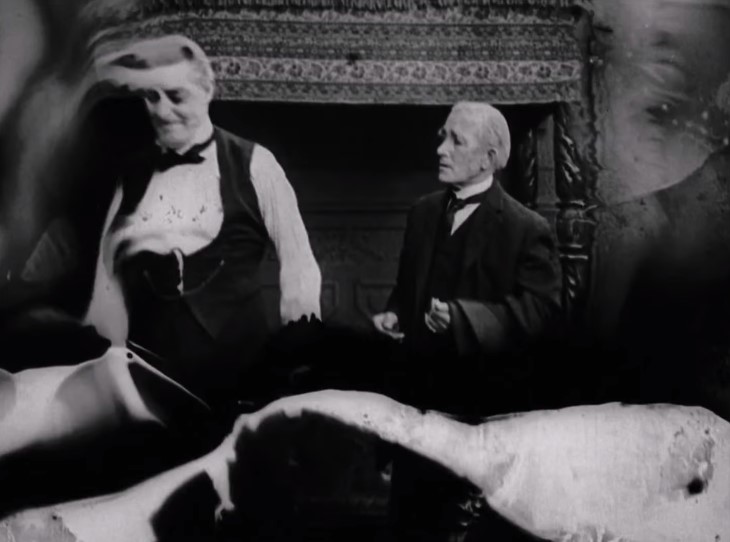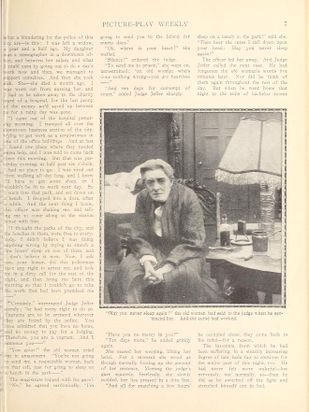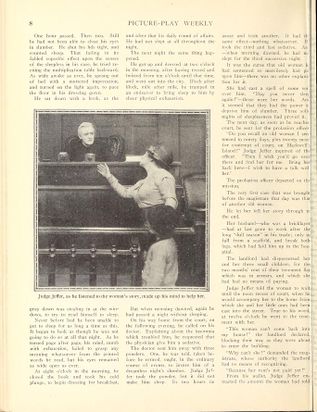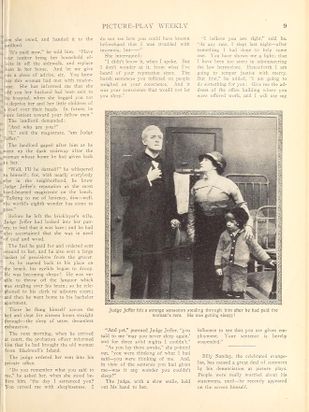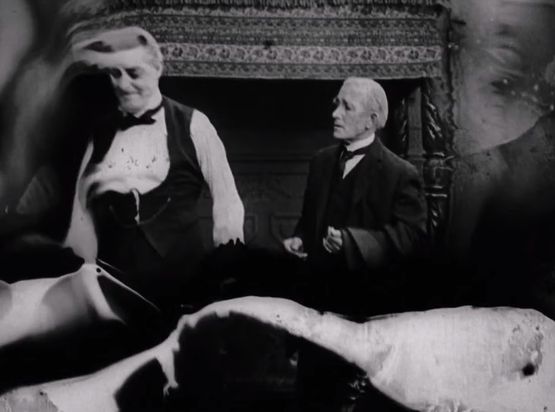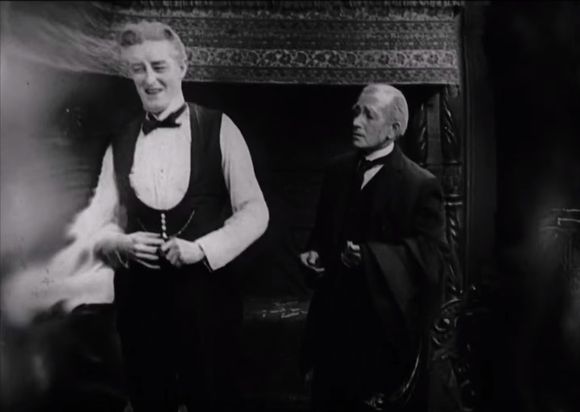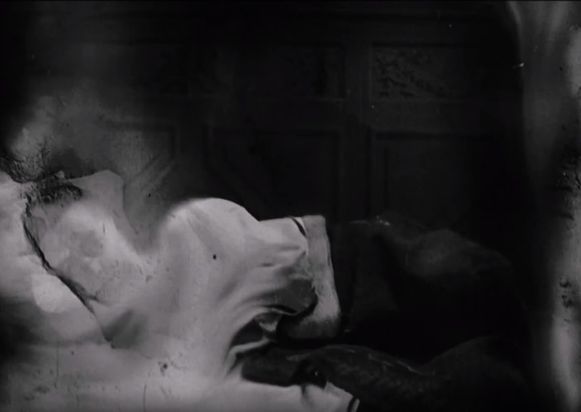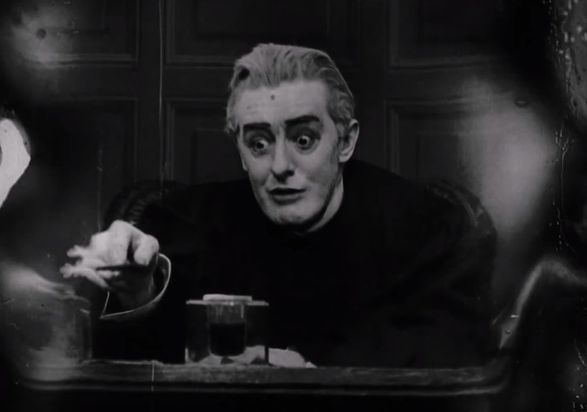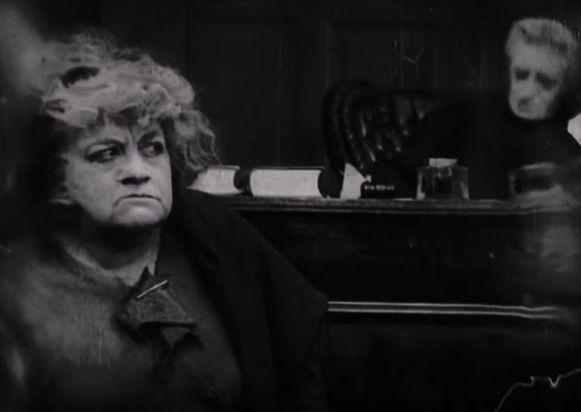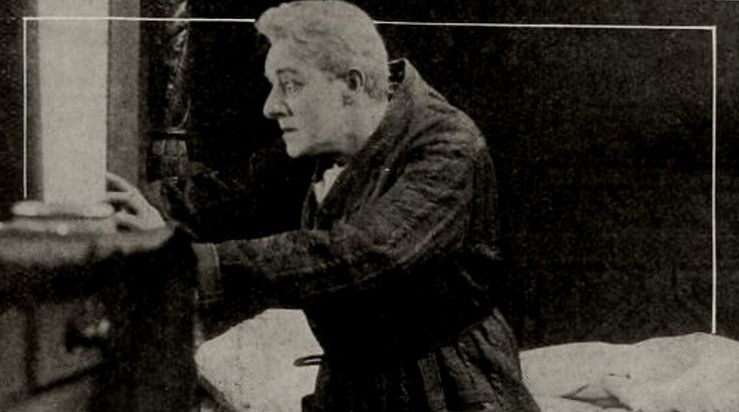The Man Who Could Not Sleep (lost silent Edison Studios film; 1915): Difference between revisions
m (updated the story description to better match the picture play retelling) |
(Tried to fix up the article's very messy grammar.) |
||
| Line 5: | Line 5: | ||
|status=<span style="color:red;">'''Lost'''</span> | |status=<span style="color:red;">'''Lost'''</span> | ||
}} | }} | ||
'''''The Man Who Could Not Sleep''''' was an early silent film made by the Edison Company who at the time had also made notable early films like ''The Kiss'', ''Alice's Adventures in Wonderland'' and ''The Great Train Robbery''. It was originally released on the 18th of May 1915 <ref>The Catalogue of Copyright Entries for 1914</ref> starring Marc McDermott as the cursed man "Judge Jeffer" of the title along with Julia | '''''The Man Who Could Not Sleep''''' was an early silent film made by the Edison Company who at the time had also made notable early films like ''The Kiss'', ''Alice's Adventures in Wonderland'' and ''The Great Train Robbery''. It was originally released on the 18th of May 1915<ref>The Catalogue of Copyright Entries for 1914</ref> starring Marc McDermott as the cursed man "Judge Jeffer" of the title along with Julia Calhoun as the woman called to court and Charles Sutton in the role of the Valet. | ||
==Plot== | ==Plot== | ||
In the film | In the film, Judge Jeffer had sentenced a woman to thirty days in prison, However, in rage against the unfair sentence, she angrily says she hopes the judge never sleeps again. The curse plays on the mind of the Judge and over the next three nights he finds himself unable to sleep due to a series of perfectly timed events. After three nights of unease and after being haunted by visions of the woman he talks with the prosecutor who says his ruling was unfair. Another woman arrives in his court along with their child for the offense of sleeping on a bench. He inquires about her sleeping conditions only to discover they live in a squalid flat and face eviction, with a moment of kindness the Judge pays her rent so she can stay however as he makes his way home he finally starts to feel sleepy. After a night of restful sleep, he calls back the woman he was harsh to have learned his lesson and works to put things right with her.<ref>[https://onlinebooks.library.upenn.edu/webbin/serial?id=mpworld Page on all the volumes of ''The Moving Pictures Magazine'', containing info on ''The Man Who Could Not Sleep''.] Retrieved 15 Apr '20</ref> | ||
==Edison's Downfall== | ==Edison's Downfall== | ||
Edison had not always had the most friendly of approaches to his film work and those practices often ended up harming his studio. In 1908 he'd teamed up with a few other companies to try and strangle the development of smaller film companies by forming “The Edison Trust” which distributed films through | Edison had not always had the most friendly of approaches to his film work and those practices often ended up harming his studio. In 1908 he'd teamed up with a few other companies to try and strangle the development of smaller film companies by forming “The Edison Trust” which distributed films through the General Film Company. However in the same year ''The Man Who Could Not Sleep'' was released, the General Film Co. was found in court to be guilty of an anti-trust violation under federal law, which meant that the collective was heavily fined and forced to disband. The result of this was that many of the companies who'd joined the trust to try and gain profit and market dominance now found themselves losing money and crippled by the consequences of it including Biograph, Selling Polyscope, Mutual, and Kalem. The Edison film studios were no exception as with the turmoil of World War I eating away at the market their finances dwindled away until the company closed for good in 1918.<ref>[https://www.loc.gov/collections/edison-company-motion-pictures-and-sound-recordings/articles-and-essays/history-of-edison-motion-pictures/ Libary of Congress article about the history of films made by Thomas Edison.] Retrieved 15 Apr '20</ref> | ||
==Preservation | ==Preservation== | ||
The film inventory was sold off to the Lincoln & Parker Film Company, when they too went bankrupt Edison bought the rights back and re-sold them off to a producer | The film inventory was sold off to the Lincoln & Parker Film Company, when they too went bankrupt soon after. Edison then bought the rights back and re-sold them off to a producer named Robert L. Giffern. The trouble is after that sale all information about the films and their locations vanished into thin air, leaving many to slowly re-emerge in film archives and private collections over the decades. ''The Man Who Could Not Sleep'' was not lucky enough to re-emerge in good shape like some of the other more famous products of the studio until it was discovered by Bill Morrison in 1999 while he was touring a number of film archives looking for footage to use in his film project ''Decasia''.<ref>[https://www.loc.gov/static/programs/national-film-preservation-board/documents/decasia.eagan.pdf Document about the creation of ''Decasia''] Retrieved 15 Apr '20</ref> The film was in the final stages of nitrate decomposition and had been put aside by archivists to be disposed of due to the extremely dangerous threat the material now posed to their collections. Bill copied footage from the disintegrating reels and used decayed footage from four brief shots for his film; which now are the only known extant examples of footage from the film. Although the cut was being re-rendered in slow motion, unfortunately, the cut lacks any consecutive or complete frames in good condition. So barring the occasional partial frame the film is still considered lost with no intact footage. | ||
As of | As of April 3rd, 2021, The Library of Congress has confirmed during an email inquiry that they still have a copy of this film, however, there is almost no stills left on their print due to the severe nitrate decay. | ||
==Picture Play Weekly== | ==Picture Play Weekly== | ||
In the early days of Cinemas an alternative way to get the story of the film would be to read the various fan magazines that covered popular movies of the time and in the magazine serial "Picture Play Weekly" (particularly in Volume 1) it featured a novelization of this film including some set photographs for illustrations, So while no footage from the film is known to survive the plotline can at least be followed somewhat faithfully based on this adaption.<ref> Picture Play Weekly Volume 1 </ref> | In the early days of Cinemas, an alternative way to get the story of the film would be to read the various fan magazines that covered popular movies of the time, and in the magazine serial "Picture Play Weekly" (particularly in Volume 1) it featured a novelization of this film including some set photographs for illustrations, So while no footage from the film is known to survive the plotline can at least be followed somewhat faithfully based on this adaption.<ref>Picture Play Weekly Volume 1</ref> | ||
<gallery mode=packed heights=275px> | <gallery mode=packed heights=275px> | ||
| Line 29: | Line 29: | ||
==Gallery== | ==Gallery== | ||
<gallery mode=packed heights=275px> | <gallery mode=packed heights=275px> | ||
File:Manwhocouldnotsleep1.jpg | File:Manwhocouldnotsleep1.jpg | ||
File:MwcnSleep3.jpg | File:MwcnSleep3.jpg | ||
File:MwcnSleep4.jpg | File:MwcnSleep4.jpg | ||
File:MwcnsSleep5.jpg | File:MwcnsSleep5.jpg | ||
File:Mwcnsleep6.jpg | File:Mwcnsleep6.jpg | ||
File:Manwhocouldnotsleep2.jpg | File:Manwhocouldnotsleep2.jpg | ||
</gallery> | </gallery> | ||
==External Links== | ==External Links== | ||
*[http://billmorrisonfilm.com/feature-length-films/decasia/1 Bill Morrison Website Page for ''Decasia''.] | *[http://billmorrisonfilm.com/feature-length-films/decasia/1 Bill Morrison Website Page for ''Decasia''.] Retrieved 15 Apr '20 | ||
*[https://www.imdb.com/title/tt1276404/?ref_=ttpl_pl_tt IMDb's page on the film.] | *[https://www.imdb.com/title/tt1276404/?ref_=ttpl_pl_tt IMDb's page on the film.] Retrieved 15 Apr '20 | ||
==References== | ==References== | ||
Revision as of 14:28, 3 April 2021
The Man Who Could Not Sleep was an early silent film made by the Edison Company who at the time had also made notable early films like The Kiss, Alice's Adventures in Wonderland and The Great Train Robbery. It was originally released on the 18th of May 1915[1] starring Marc McDermott as the cursed man "Judge Jeffer" of the title along with Julia Calhoun as the woman called to court and Charles Sutton in the role of the Valet.
Plot
In the film, Judge Jeffer had sentenced a woman to thirty days in prison, However, in rage against the unfair sentence, she angrily says she hopes the judge never sleeps again. The curse plays on the mind of the Judge and over the next three nights he finds himself unable to sleep due to a series of perfectly timed events. After three nights of unease and after being haunted by visions of the woman he talks with the prosecutor who says his ruling was unfair. Another woman arrives in his court along with their child for the offense of sleeping on a bench. He inquires about her sleeping conditions only to discover they live in a squalid flat and face eviction, with a moment of kindness the Judge pays her rent so she can stay however as he makes his way home he finally starts to feel sleepy. After a night of restful sleep, he calls back the woman he was harsh to have learned his lesson and works to put things right with her.[2]
Edison's Downfall
Edison had not always had the most friendly of approaches to his film work and those practices often ended up harming his studio. In 1908 he'd teamed up with a few other companies to try and strangle the development of smaller film companies by forming “The Edison Trust” which distributed films through the General Film Company. However in the same year The Man Who Could Not Sleep was released, the General Film Co. was found in court to be guilty of an anti-trust violation under federal law, which meant that the collective was heavily fined and forced to disband. The result of this was that many of the companies who'd joined the trust to try and gain profit and market dominance now found themselves losing money and crippled by the consequences of it including Biograph, Selling Polyscope, Mutual, and Kalem. The Edison film studios were no exception as with the turmoil of World War I eating away at the market their finances dwindled away until the company closed for good in 1918.[3]
Preservation
The film inventory was sold off to the Lincoln & Parker Film Company, when they too went bankrupt soon after. Edison then bought the rights back and re-sold them off to a producer named Robert L. Giffern. The trouble is after that sale all information about the films and their locations vanished into thin air, leaving many to slowly re-emerge in film archives and private collections over the decades. The Man Who Could Not Sleep was not lucky enough to re-emerge in good shape like some of the other more famous products of the studio until it was discovered by Bill Morrison in 1999 while he was touring a number of film archives looking for footage to use in his film project Decasia.[4] The film was in the final stages of nitrate decomposition and had been put aside by archivists to be disposed of due to the extremely dangerous threat the material now posed to their collections. Bill copied footage from the disintegrating reels and used decayed footage from four brief shots for his film; which now are the only known extant examples of footage from the film. Although the cut was being re-rendered in slow motion, unfortunately, the cut lacks any consecutive or complete frames in good condition. So barring the occasional partial frame the film is still considered lost with no intact footage.
As of April 3rd, 2021, The Library of Congress has confirmed during an email inquiry that they still have a copy of this film, however, there is almost no stills left on their print due to the severe nitrate decay.
Picture Play Weekly
In the early days of Cinemas, an alternative way to get the story of the film would be to read the various fan magazines that covered popular movies of the time, and in the magazine serial "Picture Play Weekly" (particularly in Volume 1) it featured a novelization of this film including some set photographs for illustrations, So while no footage from the film is known to survive the plotline can at least be followed somewhat faithfully based on this adaption.[5]
Gallery
External Links
- Bill Morrison Website Page for Decasia. Retrieved 15 Apr '20
- IMDb's page on the film. Retrieved 15 Apr '20
References
- ↑ The Catalogue of Copyright Entries for 1914
- ↑ Page on all the volumes of The Moving Pictures Magazine, containing info on The Man Who Could Not Sleep. Retrieved 15 Apr '20
- ↑ Libary of Congress article about the history of films made by Thomas Edison. Retrieved 15 Apr '20
- ↑ Document about the creation of Decasia Retrieved 15 Apr '20
- ↑ Picture Play Weekly Volume 1
